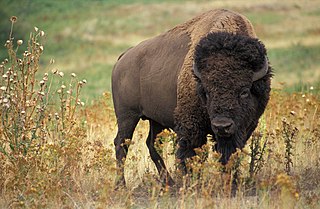
A bison is a large bovine in the genus Bison within the tribe Bovini. Two extant and numerous extinct species are recognised.

The San Diego Zoo Safari Park, originally named the San Diego Wild Animal Park until 2010, is an 1800-acre zoo in the San Pasqual Valley area of San Diego, California, near Escondido. It is one of the largest tourist attractions in San Diego County. The park houses a large array of wild and endangered animals from every continent, except Antarctica; this includes the largest, most comprehensive collection of hoofed mammals (ungulates) in the world. The park is in a semi-arid environment, about 30 miles (48 km) inland from the Pacific Ocean, giving it a year-round ‘feeling’ of being in Africa, with one of its most notable attractions being the Africa Tram, a half-hour guided tram ride which showcases the expansive ‘grassland’ exhibits. These free-range enclosures house the majority of the park's larger species, such as numerous antelopes, giraffes, buffalo, cranes, and rhinoceros, among others. The park is also noted for its California condor breeding program. When booked in-advance, the park also offers several longer, more in-depth safari options, some of which involve riding in an open-top truck to feed the animals in the field enclosures.

The European bison or the European wood bison, also known as the wisent, the zubr, or sometimes colloquially as the European buffalo, is a European species of bison. It is one of two extant species of bison, alongside the American bison. The European bison is the heaviest wild land animal in Europe, and individuals in the past may have been even larger than their modern-day descendants. During late antiquity and the Middle Ages, bison became extinct in much of Europe and Asia, surviving into the 20th century only in northern-central Europe and the northern Caucasus Mountains. During the early years of the 20th century, bison were hunted to extinction in the wild.

The American bison, also called the American buffalo or simply buffalo, is a species of bison native to North America. It is one of two extant species of bison, alongside the European bison. Its historical range, by 9000 BCE, is described as the great bison belt, a tract of rich grassland that ran from Alaska to the Gulf of Mexico, east to the Atlantic Seaboard, as far north as New York, south to Georgia, and according to some sources, further south to Florida, with sightings in North Carolina near Buffalo Ford on the Catawba River as late as 1750.
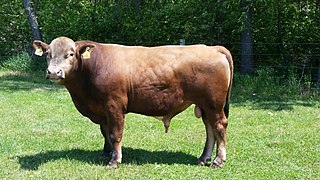
Beefalo constitute a hybrid offspring of domestic cattle, usually a male in managed breeding programs, and the American bison, usually a female in managed breeding programs. The breed was created to combine the characteristics of both animals for beef production.

Marine Corps Base Camp Pendleton is the major West Coast base of the United States Marine Corps and is one of the largest Marine Corps bases in the United States. It is on the Southern California coast in San Diego County and is bordered by Oceanside to the south, San Clemente and Orange County to the north, Riverside County to the northeast, and Fallbrook to the east.

The Houston Zoo is a 55-acre (22 ha) zoological park located within Hermann Park in Houston, Texas, United States. The zoo houses over 6,000 animals from more than 900 species. It receives around 2 million visitors each year and is the second most visited zoo in the United States, surpassed only by the San Diego Zoo. It is accredited by the Association of Zoos and Aquariums (AZA).

Antelope Island, with an area of 42 square miles (109 km2), is the largest of ten islands located within the Great Salt Lake in Utah. The island lies in the southeastern portion of the lake, near Salt Lake City and Davis County, and becomes a peninsula when the lake is at extremely low levels. It is protected as Antelope Island State Park.

San Onofre State Beach is a 3,000-acre (1,214 ha) state park in San Diego County, California. The beach is 3 miles (5 km) south of San Clemente on Interstate 5 at Basilone Road. The state park is leased to the state of California by the United States Marine Corps. Governor Ronald Reagan established San Onofre State Beach in 1971. With over 2.5 million visitors per year, it is one of the five most-visited state parks in California, hosting swimmers, campers, kayakers, birders, fishermen, bicyclists, sunbathers, surfers, and the sacred Native American site of Panhe.

John Basilone was a United States Marine Corps Gunnery Sergeant who received the Medal of Honor for actions during the Battle for Henderson Field in the Guadalcanal campaign, and the Navy Cross posthumously for extraordinary heroism during the Battle of Iwo Jima. He was the only enlisted Marine to receive both of these decorations in World War II.

The wood bison or mountain bison, is a distinct northern subspecies or ecotype of the American bison. Its original range included much of the boreal forest regions of Alaska, Yukon, western Northwest Territories, northeastern British Columbia, northern Alberta, and northwestern Saskatchewan.

The Plains bison is one of two subspecies/ecotypes of the American bison, the other being the wood bison. A natural population of Plains bison survives in Yellowstone National Park and multiple smaller reintroduced herds of bison in many places in the United States as well as southern portions of the Canadian Prairies.

The Catalina Island Conservancy is a nonprofit organization established to protect and restore Santa Catalina Island, California, United States. The Conservancy was established in 1972 through the efforts of the Wrigley and Offield families. The Conservancy was created when both families deeded 42,135 acres (170.51 km2) of the island over to the organization—88% of the Island.

In Defense of Animals (IDA) is an animal protection organization founded in 1983 in San Rafael, California, US. The group's slogan is "working to protect the rights, welfare, and habitats of animals".
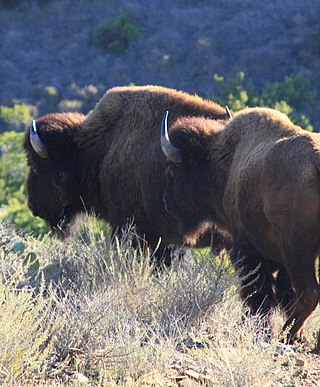
The Catalina Island bison herd is a small group of introduced American bison living on Catalina Island off the coast of Southern California. In 1924, several bison were acquired and, before the end of 1925, brought to Catalina. The bison are now quite popular with the tourists. Some buildings have been painted with images of bison and decorated with bison weather vanes. Over the decades, the bison herd numbered as many as 600. The population currently numbers approximately 100.
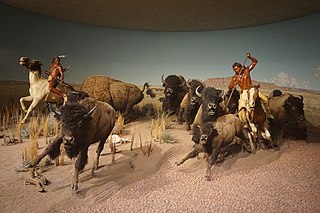
Bison hunting was an activity fundamental to the economy and society of the Plains Indians peoples who inhabited the vast grasslands on the Interior Plains of North America, before the animal's near-extinction in the late 19th century following US expansion into the West. Bison hunting was an important spiritual practice and source of material for these groups, especially after the European introduction of the horse in the 16th through 19th centuries enabled new hunting techniques. The species' dramatic decline was the result of habitat loss due to the expansion of ranching and farming in western North America, industrial-scale hunting practiced by non-Indigenous hunters increased Indigenous hunting pressure due to non-Indigenous demand for bison hides and meat, and cases of a deliberate policy by settler governments to destroy the food source of the Indigenous peoples during times of conflict.
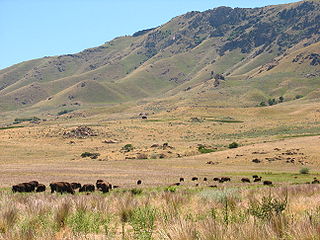
The Antelope Island bison herd is a semi–free-ranging population of American bison in Antelope Island State Park in Great Salt Lake, Utah. Bison were introduced to Antelope Island in 1893. The herd is significant because it is one of the largest and oldest publicly owned bison herds in the nation. The Antelope Island bison herd currently numbers between 550 and 700 individuals. Though the bison on Antelope Island are Prairie bison, which was the most common bison subspecies in North America, the bison have a distinct genetic heritage from many of the other bison herds in the United States and they are considered to be desirable as part of the breeding and foundation stock for other bison herds, because of their separate genetic heritage and some of the distinct genetic markers that are found in the population.

The Yellowstone bison herd roams the Greater Yellowstone Ecosystem. The bison herd is probably the oldest and largest public bison herd in the United States, estimated in 2020 to comprise 4,800 bison. The bison are American bison of the Plains bison subspecies. Yellowstone National Park may be the only location in the United States where free-ranging bison were never extirpated, since they continued to exist in the wild and were not reintroduced.

The conservation of bison in North America is an ongoing, diverse effort to bring American bison back from the brink of extinction. Plains bison, a subspecies, are a keystone species in the North American Great Plains. Bison are a species of conservation concern in part because they suffered a severe population bottleneck at the end of the 19th century. The near extinction of the species during the 1800s unraveled fundamental ties between bison, grassland ecosystems, and indigenous peoples’ cultures and livelihoods.# English speakers used the word buffalo for this animal when they arrived. Bison was used as the scientific term to distinguish them from the true buffalo. Buffalo is commonly used as it continues to hold cultural significance, particularly for Indigenous people. Recovery began in the late 1800s with a handful of individuals independently saving the last surviving bison.# Dedicated restoration efforts in the 1900s bolstered bison numbers though they still exist in mostly small and isolated populations. Expansion of the understanding of bison ecology and management is ongoing. The contemporary widespread, collaborative effort includes attention to heritage genetics and minimal cattle introgression.#

The Fermilab bison herd was established in 1969 at the U.S. national laboratory in Batavia, Illinois, about 34 mi (55 km) west of Chicago, under the leadership of physicist, amateur architect and Wyoming native Robert R. Wilson. The herd grazes an 800-acre pasture adjacent to the Fermilab prairie, which sits atop the accelerator's underground Main Ring and Tevatron. The herd usually averages around 25 individuals; as of spring 2022, the head count of the herd was 32 individuals.



















